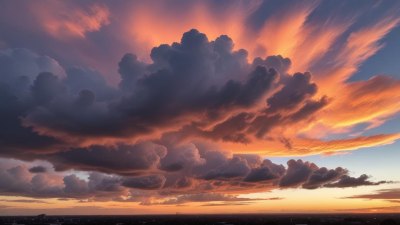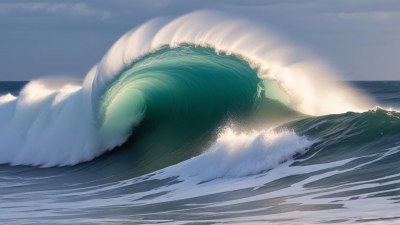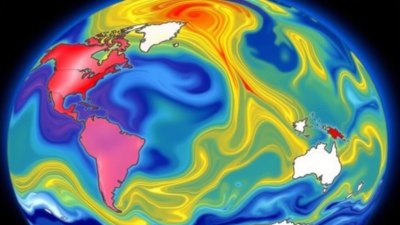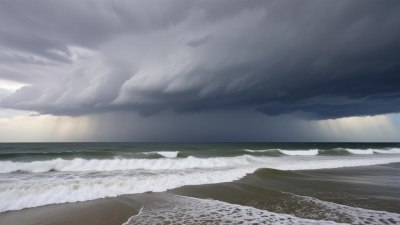Why the Clouds Always Show Up Fashionably Late for Sunset
Discover why clouds add a touch of magic to sunsets but often arrive late to the show.

This image was created with the assistance of Freepik
Sunsets have long captivated humanity—imbuing the horizon with colors that range from fiery reds to deep purples. One might expect that clouds, ever present in the sky, would join in this spectacular finale of the day with timing as punctual as the sun’s descent. Yet, they often arrive later than expected, leading to the whimsical notion that clouds are fashionably late. Through a scientific lens, we explore why this delightful phenomenon occurs and what role clouds play in enhancing our sunset experiences.
Understanding Clouds
Before diving into the reasons for clouds' tardiness, it’s essential to understand what clouds are. Clouds are made up of tiny water droplets or ice crystals that cluster together in the atmosphere. They form through processes like evaporation and condensation, often driven by temperature changes and atmospheric conditions. There are various types of clouds, classified generally into cumulus, stratus, and cirrus, each contributing differently to the landscape of a sunset.
The Role of the Atmosphere
The atmosphere is a dynamic system that affects how we perceive light during sunset. As the sun sets, its light must travel through more atmosphere, causing scattering—a phenomenon famously explained by Rayleigh scattering. This scattering process allows us to witness the stunning orange, pink, and purple hues that define a sunset. However, clouds don't always play along; they may shift or form later in the evening, altering our anticipated view.
Types of Clouds and Their Timing
Different types of clouds have distinct behaviors and formations. Cumulus clouds, for example, often form on warm days and may dissipate as the sun sets, while stratocumulus clouds may appear as the temperature drops. Additionally, clouds tend to be more prevalent in certain seasons, influenced by meteorological patterns, such as monsoon or winter storms, which can dictate their visibility as daylight wanes.
The Illusion of Tardiness
When observing a sunset, it may seem like clouds have arrived late, but this is often an illusion created by our perspective. The sun's position in the sky changes due to the Earth’s rotation, and as it descends, it illuminates clouds that may have formed earlier in the day. Thus, we perceive an ethereal glow emanating from these clouds—an effect that can be mistaken for late arrivals.
Geographical Factors
Your location can significantly influence when clouds make their appearance. Coastal regions, for instance, might see marine layer clouds rolling in as the sun sets, often creating enchanting views as they are illuminated by the sinking sun. In contrast, mountainous regions can experience clouds forming rapidly in the evening due to terrain and temperature differentials. Understanding these geographical patterns helps explain the differences in sunset cloud dynamics across various locations.
Time of Day and Temperature Variations
Temperature plays a crucial role in cloud formation. As daytime temperatures fall, conditions become favorable for cloud creation. As the sun nears the horizon, the differential heating causes turbulence in the lower atmosphere, which can lead to the late formation of clouds. This interplay highlights how cooling temperatures can lead to clouds appearing just in time to catch the last rays of sunlight.
Meteorological Conditions
Specific weather patterns can influence cloud behavior significantly, causing them to appear or dissipate unexpectedly during sunsets. High pressure systems can lead to clear skies, while low pressure systems might bring in cloud cover later in the day. Understanding local weather forecasts provides insights into cloud behavior, enabling us to anticipate how they may enhance our sunset experience.
Emotional and Psychological Effects
The sight of clouds at sunset often elicits emotional responses, causing us to reflect on the beauty of nature. Those vibrant hues mixed with clouds create moments of awe, prompting consideration of our place in the grand tapestry of life. Our expectation of clouds, combined with their unpredictable nature, leads to a heightened appreciation for sunsets and their fleeting beauty.
The Aesthetic Appeal of Late Clouds
When clouds do appear at sunset, they can dramatically enhance the visual appeal of the sky. Reflected light from the sun illuminates these clouds, bringing forth rich textures and breathtaking colors. The interplay between sun and cloud creates depth and drama, ultimately leading to unforgettable sunset experiences. Artists have long been inspired by such vistas, capturing these moments in visual masterpieces.
Technology and Cloud Observation
Thanks to advancements in technology, we can better understand cloud behaviors and even predict potential sunset conditions. Satellite imagery and weather radars allow meteorologists to provide real-time updates about cloud formations, offering enthusiasts insights for planning their sunset outings. The blending of nature and technology helps nurture our connection to the skies.
The Science of Sunsets
Beyond aesthetic pleasure, studying the science behind sunset colors and their interactions with clouds leads to a deeper appreciation of atmospheric phenomena. The light scattering responsible for the stunning colors we admire reflects fundamental physics and chemistry, contributing to humanity’s understanding of our environment. The beauty found in sunsets emphasizes the complex interplay of natural forces.
Clouds Across Different Regions
Various geographical locations exhibit different sunset cloud behaviors. In arid regions, for instance, the absence of moisture typically results in clearer skies, making sunsets dramatic in their simplicity. Over oceans, the maritime environment tends to generate more cloud cover, creating equally mesmerizing sunset displays, albeit in a different context. Understanding these differences adds layers to our sunset experiences.
The clouds that seem to arrive fashionably late for sunset may be a result of a myriad of factors, including atmospheric conditions, temperature variations, and geographical influences. Rather than detracting from the beauty of sunsets, these clouds enhance their splendor. By embracing the unpredictability of clouds, we allow ourselves to marvel at nature's artistry. The next time you witness a breathtaking sunset, take a moment to appreciate the clouds’ role in crafting that unforgettable moment.











